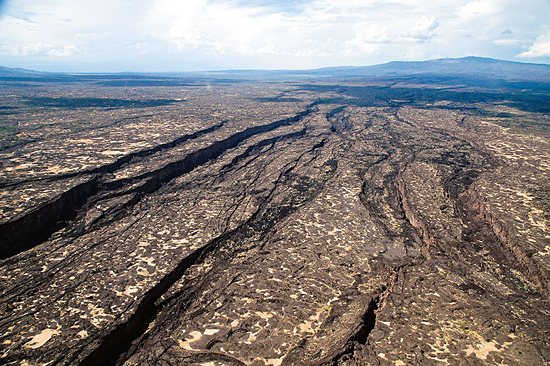

Geophysics
An Ocean is Born?
A geological rift offers Rochester geophysicist Cindy Ebinger a glimpse into the physics of how continents move.
By Jonathan Sherwood ’04 (MA)

GROWING RIFT: Ebinger and other scientists say a geological rift in northeastern Ethiopia is an unusual chance to analyze the forces at work behind plate tectonics.
Once described by National Geographic as “the cruelest place on Earth,” the Afar Depression in the Horn of Africa is a forbidding site, even for the most diehard geological scientist.
But Cindy Ebinger, a professor of earth and environmental sciences at Rochester, and her colleagues have been traveling for the past several years to the region where the countries of Ethiopia, Eritrea, and Djibouti meet. There, in a vast desert of sand and salt, where temperatures regularly rise above 120 degrees, Ebinger and an international team of geophysicists are documenting one of the most unusual geological events in modern history—the possible birth of an ocean in the middle of a desert.
In September 2005, northeastern Ethiopia was rocked by the eruption of Mt. Dabbahu and a cascade of 163 earthquakes, some as strong as 5.6 on the Richter scale. The quakes tore open a quarter mile long, 200-foot deep rift in the shoulder of the volcano. In some places the ground snapped apart, thrusting rock walls, called scarps, a dozen feet into the air.
“The scene from the helicopter window looked like the set of a Hollywood disaster film,” says Ebinger. “They have a propensity to exaggerate earthquakes, but with the 12-inch wide open fissures and 6-foot high cliffs that opened in a two-day period, the land was so torn up that that’s really what it looked like.”
Ebinger, along with her colleague Derek Keir, a professor of geology at the University of London, were among the first to fly into the area to explore the geological forces at work as the rift widened. They, along with other scientists, have hypothesized that the Afar rift zone may provide a picture of how tectonic plates—the continental-sized sections of the Earth’s core—grind together or slide away from each other. The slow movement of those plates have, over millennia, resulted in the distribution of continents and oceans on the surface of the Earth.
The Afar rift zone was intriguing because most known active rift zones lie on the seafloor, under three miles of crushing ocean, where they cannot be measured consistently. Taking place on dry land, the zone, scientists say, would be the first time in human history when the process could be observed, monitored, and measured in exacting detail. Such information would add volumes to the understanding of the basic physics of plate tectonics.
Specifically, Ebinger hoped to discover what drives the separation as rifts spread apart, both in the Afar desert and on the seafloor. In the mid-Atlantic ridge, for instance, a 1,000-mile rift in the ocean floor seethes as molten magma bubbles up from the Earth’s interior. On opposite sides of the rift lie the North American and the European tectonic plates, and they are creeping apart from each other at about 2.2 inches a year, taking their respective continents with them.
“We wanted to find out if these tectonic plates rupture by fracturing, or if the magma is ramming itself into cracks, adding to the forces pulling the plates apart,” says Ebinger. “These magma-filled cracks, or dikes, are usually overlooked.”
Ebinger and Keir described their findings this spring in Geophysical Journal International. Ebinger writes that the magma appears to be the force elbowing the two plates aside.
In winter 2007, Ebinger and her students buried 15 seismic detectors in the Afar Depression, hoping to catch the sounds of rock fracture and magma movement deep in the Earth as the plates moved apart. The team and Ethiopian colleagues braved prohibitive heat, scarcity of water, and political unrest to lay a network of detectors to triangulate the source of the slightest tremors in the rift area, and to use the shape of the recorded waves to understand the physics of plate rupture. The team even trekked to the small Ethiopian district of Afdera, the hottest permanently inhabited place on Earth, to bury a device.
Over the course of a year, Ebinger and her team monitored the area through seismometers, satellites, and global positioning systems. The satellites mapped the changes in elevation in several parts of the depression, and Ebinger noticed that some areas were swelling up—by just a few inches, but enough to indicate that molten, not solid, rock, was pushing up beneath the desert.
At the same time, seismometers were recording hundreds of tiny earthquakes in the region. Ebinger triangulated the recordings and found that these miniquakes were clustered in areas that correlated well with the satellites’ swelling data. The triangulation was so precise, in fact, that Ebinger’s team could see that the clusters had large “hollow” spaces inside them—areas where no quakes were occurring at all. Ebinger believes only one thing could explain that finding: buoyant magma pressing toward the surface. No miniquakes can happen inside the liquid magma itself, but as the magma presses against the surrounding bedrock, the rocks fracture and split, sending shivers through the Earth that the seismometers can detect.
That evidence strongly suggests to Ebinger that the force of magma injecting itself between the plates is causing the split. Much more testing and monitoring must be done before Ebinger’s hypothesis can be definitively proven, but her work hints at the mechanisms that drive such splits, shedding light on how and why the Atlantic is widening, and how, in perhaps a scant few million years, the cruelest place on Earth may become prime beachfront property.
Jonathan Sherwood ’04 (MA) is a senior science writer for University Communications.
